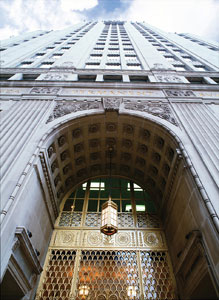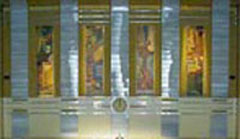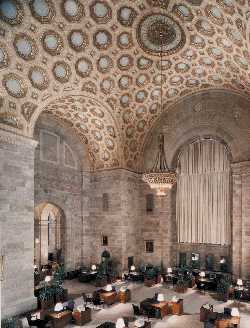|
Monday, May 30, 2005
Visiting 3 Beauties from the 1930s
Being the architecture buff that I am, I have really been looking
forward to checking out Toronto’s free architecture festival:
Doors Open. A few years
ago I went to Chicago with a few friends for a May long weekend,
right at the time when Chicago’s architecture festival was
on, and I am really happy that Toronto now has an architecture festival
of its own.
The architectural period I am most fascinated with is the Jazz
Age and the early part of the Great Depression, the era of the Roaring
Twenties and the much less roaring Thirties, when the Art Deco skyscraper
really came of age.
So it was only fitting that my good friend Shauna, another aficionado
of Art Deco, and I would pick a few beauties dating back to that
era from the 144 buildings that opened their doors to the public
for free. We started with the Beaux-Arts / neoclassical Canada Life
Building, built on University Avenue, Toronto’s biggest thoroughfare.

At 17 stories it was the tallest building when it opened in 1931.
We admired the lobby with its thousands of decorative details, guilded
ceilings and marble floors and columns. Then we took the elevator
up to the 17th story Tower Room, a rather small room with windows
on 3 sides and beautiful views of downtown Toronto, that previously
was used as a boardroom.
The final touch was the “Canada Life Environmental Room”
in the newer Canada Life Building next door which houses a variety
of plants and aquatic creatures along walls made from lava rock.
It looks like a tropical rain forest and is a joint project with
the University of Guelph to study the effect of plants on indoor
air quality. Quite a serene place that is used for meetings, presentations
and even weddings.

Just about 10 minutes away at 320 Bay Street we visited the next
architectural beauty: the Canada Permanent Building, also constructed
between 1928 and 1930. It features Classical Revival Styling with
Art Deco influences and the visually astounding Banking Hall with
its marble floors, high ceilings, and Art Deco chandeliers, reproductions
that were hand-crafted from photographs as the original chandeliers
were lost when the building closed. The Safety Deposit Vault with
its exquisitely crafted brass gates, is also accessible, it has
now been turned into a conference room. Last but not least, we admired
the elevator doors that are decorated with bas-relief brass panels,
showing a variety of mythical figures, as well as an original mail
chute from the 1930s, the only such mail chute in Toronto still
in active use today.
Our next stop was the Design Exchange, actually the former Toronto
Stock Exchange Building. It was completed in 1937 and shows a much
stronger Art Deco and Streamlined Moderne influence. The masterpiece
of streamline design is the Inco Staircase, constructed in stainless
steel with lacquered birch handrails. A very interesting feature
is the suspended light fixture with vertical fluorescent tubes behind
ribbed transparent panels.

The most spectacular portion of the Design Exchange is the former
Toronto Stock Exchange trading floor. It features 8 giant murals,
4 on the west and 4 on the east side, painted by Canadian artist
Charles Comfort, which portray topics from the 1930s such as transportation
& communication, pulp & paper, construction & engineering,
agriculture, the oil industry, mining, nickel and gold production.
The Trading Floor has rounded ceiling corners and triple banding
that stretch around the room.
We walked one floor up from the Trading Floor and saw an interesting
exhibition on examples of low-cost yet effective Canadian architecture,
showing recent public buildings (libraries, university buildings,
community centres) that were built at half or even one third the
cost per square foot of an average condominium building (C$303 per
square foot). Behind the PSF exhibition we also visited the "TSA
Poster Competition" which exhibits entrants in the Toronto
Society of Architects poster competition celebrating May as Architecture
and Design Month. On the north side of the building we also visited
the only permanent collection of modern Canadian industrial design
in the country where we admired post-war designs of tea kettles,
chairs and furniture, thermos bottles, Tupperware dishes, electric
frying pans and various other household items. It was funny seeing
a lot of these items in a museum setting since a lot of them can
still be seen in active use in Canadian households today.
Our final stop was Commerce Court, a monumental 34 story building
that opened in 1930. The majestic banking hall with its beautiful
ceiling was closed and we couldn’t get in but we nevertheless
got a taste of this amazing architectural gem through the locked
glass doors.

Since it had started to rain and we had no umbrellas, we headed
underground again, into “PATH”,
downtown Toronto's underground walkway linking 27 kilometres of
shopping, services and entertainment. PATH connects about 1,200
retail shops and services and more than 50 buildings / office towers.
20 parking garages, 5 subway stations, 2 major department stores,
6 major hotels, and a railway terminal are also accessible through
PATH.
We reached our underground parking at Royal Thomson Hall in the
climatized comfort of this underground network of walkways without
experiencing a single drop of rain. We both had a fabulous time
on our treasure hunt for architectural jewels from the 1930s, thanks
to Doors Open.
Useful books about Toronto:
Related articles:
An interview with Kristen Juschkewitsch, in charge of Doors
Open
Toronto - A pretty
hip place
Toronto - Sights,
Culture, Shopping
Toronto - Festival,
parks, sports and recreation
Check out why I love Toronto
|